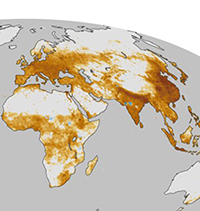Atmospher Sci & Global Chg
Research Highlights
October 2013
Cutting Greenhouse Gases to Curb Climate Change also Saves Lives
Global analysis shows the air pollution benefit of climate policy

World map of areas around the world where fine particulate matter in air pollution causes the most deaths. Dark brown represents higher numbers of premature deaths than light brown. Areas in blue are where air quality has improved. The information compares data from the 1850s to 2000, with average number of deaths per 1,000 square kilometers. Enlarge Image for Global Map. Graphic courtesy of NASA.
Results: Reducing greenhouse gas emissions to slow the rate of climate change is not the news. Quantifying the benefit in terms of air quality and human lives is. Pacific Northwest National Laboratory was part of a multi-institutional research team that found reductions in air pollution levels might justify cutting greenhouse gas emissions, which often go hand-in-hand with harmful air pollutants. Known as a "co-benefit," using state of the art models for human and natural systems, along with climate projections from the international community, the team was able for the first time to put a value on the global air pollution benefits of cutting greenhouse gas emissions over the 21st century. They showed that reducing greenhouse gases not only slows climate change, it prevents millions of premature deaths. The research appeared September 25 in online versions of the prestigious journal Nature Climate Change.
This study was a collaborative effort involving researchers from the University of North Carolina Chapel Hill, Pacific Northwest National Laboratory, Princeton University, the U.S. Environmental Protection Agency, NOAA, and the National Center for Atmospheric Research.
Why It Matters: In addressing the co-benefits of cutting greenhouse gas emissions, past studies typically focused on near-term and local benefits for air quality and human health. This research looked at long-term demographic changes, the long-range transport of air pollutants and the influence of climate change on air quality. They showed that reducing greenhouse gas emissions from burning fossil fuels also reduces the pollution that causes millions of premature deaths in societies around the world.
Methods: The team used new relationships between chronic mortality and exposure to fine particulates and ozone, global modeling methods and new future climate scenarios to simulate the co-benefits of global greenhouse gas reductions on air quality and human health. They looked at two mechanisms for producing that reduction: reducing co-emitted air pollutants, and slowing climate change and the resulting effects on air quality.
See coverage from Nature Climate Change News and UNC news release to learn more. See related PNNL research, The Future of Clean Air.
Acknowledgments
Sponsors: The research was funded by the U.S. Environmental Protection Agency (EPA), the U.S. Department of Energy Office of Science's Integrated Assessment Research Program, National Institutes of Health's National Institute of Environmental Health Sciences, the Portuguese Foundation for Science and Technology, and the EPA STAR Graduate Fellowship. The study used NOAA computing resources.
Research Team: J. Jason West, Raquel A. Silva, Yuqiang Zhang, Zachariah Adelman and Meridith M. Fry, University of North Carolina Chapel Hill; Steven J. Smith, Pacific Northwest National Laboratory; Vaishali Naik, UCAR/NOAA Geophysical Fluid Dynamics Laboratory; Susan Anenberg, U.S. Environmental Protection Agency (EPA); Larry W. Horowitz, NOAA Geophysical Fluid Dynamics Laboratory; and Jean-Francois Lamarque, National Center for Atmospheric Research (NCAR).
Research Area: Climate & Earth Systems Science
Reference: West JJ, SJ Smith, RA Silva, V Naik, Y Zhang, Z Adelman, MM Fry, S Anenberg, LW Horowitz and J-F Lamarque. 2013. "Co-benefits of Mitigating Global Greenhouse Gas Emissions for Future Air Quality and Human Health." Nature Climate Change 3: 885-889. DOI:10.1038/nclimate2009.